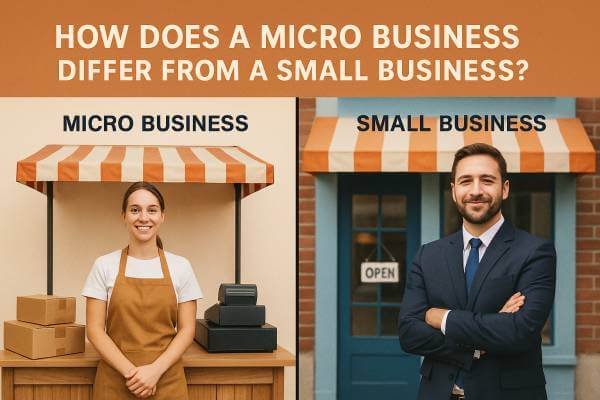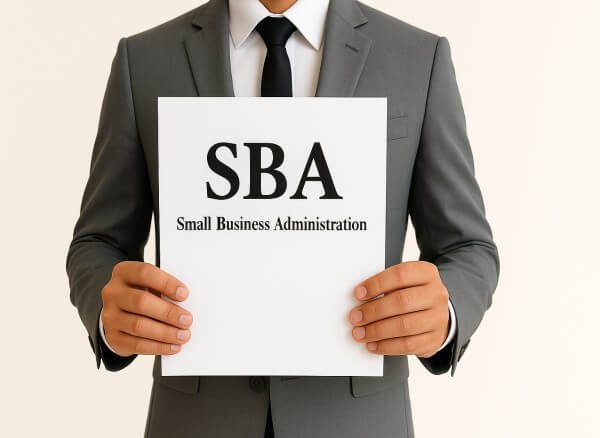Advanced Guide to What Is Considered a Small Business
You’re thinking about starting an enterprise or already running one, but you’re not quite sure if it counts as a small business. This is actually one of the most common questions new entrepreneurs ask.
Understanding the definition of small businesses can assist you in determining the benefits, loans, and resources you may be eligible for. It also helps you set realistic goals, stay compliant, and make smarter decisions for the future.
In this beginner’s guide, we’re going to break it all down. We’ll look at what the government considers a small business, how things like revenue and employee count come into play, and what it means for you.
Along the way, we will also dispel a few myths. Whether you are starting a home-based side hustle, managing a growing team, or contemplating leaping into entrepreneurship, this guide is here to help you figure it out.
What Is Considered a Small Business?
This is typically defined as a privately owned company with limited revenue and a manageable number of employees. But the actual definition can vary depending on who’s asking.
In the United States, the Small Business Administration (SBA) plays a big role in setting the official guidelines.
The SBA defines a small business as one that operates independently, pursues profit, and does not hold a dominant position in its industry.
On top of that, it must fall within specific size standards based on things like industry type, number of employees, or annual revenue.
For example, a small retail store might have fewer than 100 employees, while a small manufacturing company could have up to 500. In some industries, you might still be considered a small business even if you’re pulling in millions in revenue every year.
The important lesson is that there is no universally applicable solution. The definition of a small business depends on your industry and structure.
However, understanding your business’s position can provide access to government loans, grants, and tax breaks that are specifically tailored to assist small businesses like yours.
We’ll get into the specifics of employee count and revenue limits next, but for now, just remember: being a small business isn’t about being small in ambition. It’s about fitting within the standards that help entrepreneurs grow without being overshadowed by big corporations.
SBA’s Criteria for Small Businesses
The Small Business Administration (SBA) actually decides whether your business is “small.” It’s not just about the number of people on your payroll.
The SBA uses a system called size standards to define small businesses, and these standards depend heavily on your industry.
They’re tied to something called a NAICS code (that stands for North American Industry Classification System), which is basically a fancy way to categorize what type of enterprise you’re in.
Each industry has different limits. In some fields, you’re still considered a small enterprise if you have up to 500 employees. In others, the cutoff might be 100.
Alternatively, the standard could be based on your average annual revenue over the past few years instead of the number of employees. For example, some service-based businesses are still “small” if they make under $8 million to $41.5 million a year.
Here’s a quick breakdown of how the SBA might define a small business:
- Retail or service business: under $8 million in revenue or fewer than 100 employees
- Construction: revenue under $39.5 million
- Manufacturing or wholesale trade: up to 500 employees
If you want to be sure whether your business qualifies, you’ll need to look up your NAICS code and check the specific size standard that applies.
How many employees are considered small businesses?
One of the most common questions people ask is, How many employees can you have and still be considered a small business? The answer depends on your industry, but here’s the general rule: if you have fewer than 500 employees, there’s a substantial chance your business qualifies as “small” under SBA guidelines.
Let’s break it down a little more:
- Retail and service-based businesses: typically fewer than 100 employees
- Construction companies: usually under 250 to 500 employees
- Manufacturing or mining operations: up to 500 or even 1,500 employees, depending on the product
You can have way more people on your team than most folks expect and still qualify as a small business.
This definition is actually one of the reasons many companies get access to small business loans, contracts, and grants even though they seem, well, pretty big.
Why does employee count? Your eligibility for government programs, particularly those aimed at fostering small business growth and competitiveness, is directly impacted by your employee count. It also affects things like compliance, reporting requirements, and employee benefits.
Quick tip: If you’re not sure where your business fits, check your industry’s NAICS code and compare your headcount with the SBA’s size chart. It’s not just about headcount, but it’s definitely one of the big factors.
What Revenue Qualifies as a Small Business?
Another big factor in determining whether you’re a small business is your annual revenue. And just like with employees, the numbers vary based on your industry.
How much can your business make and still be considered “small”?
According to the SBA, it can be anywhere from $1 million to $41.5 million in average annual receipts, depending on what kind of enterprise you’re in.
Here are a few examples to give you a better idea:
- Specialty trade contractors (like plumbers or electricians): under $19 million
- Retail businesses: under $9.5 to $41.5 million, depending on the product
- Professional services (marketing, consulting, etc.): under $25 to $34.5 million
- Agriculture businesses: often under $5 to $19 million
The SBA usually calculates revenue based on your average receipts over the past three years, so one great year won’t suddenly disqualify you.
If you’re a solo entrepreneur, freelancer, or new startup, you probably don’t need to worry; your revenue is likely well under these limits. But it’s still smart to know where you stand, especially if you plan to apply for SBA loans, compete for federal contracts, or seek investor funding.
Pro tip: The easiest way to find your revenue limit is to look up your NAICS code and check the SBA’s size standards table. If your average receipts fall below the listed amount, congrats, you’re officially a small business in the government’s eyes.
Why the Definition Matters
You may be curious, “I meet the requirements, but why is it important to be recognized as a small business?” What’s the answer? Opportunities!.
Being officially classified as a small business unlocks numerous benefits unavailable why it’s worth knowing where you stand:
1. You could qualify for SBA loans: The Small Business Administration offers loans with lower interest rates and more flexible terms. But they’re only available if your enterprise meets the SBA’s size standards.
2. You may be eligible for federal and state grants: There are grants designed specifically for small businesses. Knowing your classification helps you apply for the right ones.
3. You can compete for government contracts: The federal government sets aside a portion of its contracts just for small businesses. Official small status allows you to bid on projects that larger companies cannot even consider.
4. You’ll have access to free resources and support: From business development centers to training programs and mentorship, a lot of free support is available, but only to recognized small businesses.
5. It impacts your tax planning: Some tax breaks and deductions are designed specifically for small businesses, and knowing your size can help you plan smarter come tax time.
If you qualify as a small business, you can tap into support, funding, and opportunities that can seriously boost your growth.
Small Business vs Startup vs Microbusiness
While these terms may sound similar, they are not interchangeable. Understanding the difference between a small business, a startup, and a microbusiness can shape your goals, funding strategy, and even your mindset.
What is a small business?
Typically, a small business operates independently, prioritizes long-term stability, and maintains a manageable workforce and revenue. Example: restaurants, agencies, consultants, or retail shops.
What is a startup?
A startup is all about growth and scalability. Startups aim to disrupt an industry, often using tech, and usually seek outside investment to grow rapidly. They’re not necessarily small for long. Often, the goal is to expand, secure a buyout, or go public.
What is a microbusiness?
is usually defined as having fewer than 10 employees. It might be a side hustle, a solo business, or a tight-knit team. Many freelancers, consultants, and home-based businesses fall into this category.
Here’s a quick comparison:
| Type | Team Size | Goal | Funding Source |
| Small Business | 1 to 500 | Steady income, growth | Self-funded, small loans |
| Startup | Small (at first) | Rapid growth, scale | Investors, venture capital |
| Microbusiness | 1 to 9 | Local or niche impact | Personal funds, small loans |
Ultimately, not every small enterprise is a startup, and not every startup remains a small business for an extended period. Microbusinesses are technically a type of small business, but with an even smaller footprint.
Common Misconceptions About Small Businesses
There’s a lot of confusion out there about what actually counts as a small enterprise. You might be surprised at how many people get it wrong. So let’s clear up a few of the biggest myths:
Myth 1: If you make over six figures, you’re not a small business
This information is wrong. Your business can make millions of dollars and still qualify as “small” under SBA rules, depending on your industry. It’s not just about revenue; it’s also about how many employees you have and what kind of work you do.
Myth 2: Small businesses are always local shops or mom-and-pop stores
This statement is not true. While your favorite corner bakery is a small business, so is a 300-person manufacturing company or a nationwide cleaning service if they fall within the SBA’s size limits.
Myth 3: Freelancers and solo entrepreneurs don’t count
They absolutely do. If you’re self-employed and running a for-profit business, even without employees, you’re likely considered a microbusiness, which is still a type of small business.
Myth 4: Only brick-and-mortar businesses qualify
This is not right. Online businesses, remote service providers, app developers, and e-commerce stores can all fall under the small business umbrella.
Myth 5: Once you hire employees, you’re no longer a small business
This claim is false. Hiring a few employees doesn’t bump you out of the small business category. In fact, you could hire hundreds, depending on your industry, and still qualify.
The takeaway here is simple: small businesses come in all forms. Whether you’re running a side hustle, leading a growing team, or launching an online store, there’s a significant chance you fall under the small business definition.
Do You Qualify as a Small Business?
Are you uncertain about whether your business meets the criteria? Here’s a simple checklist to help you figure it out fast. If you can check most of these boxes, you’re probably operating a small business:
- You own and operate the business independently.
- Your business is for-profit and based in the U.S.
- You’re not dominant in your field (aka not a major corporation)
- You have fewer than 500 employees (depending on your industry)
- Your average annual revenue is under the SBA limit for your industry
- You’re registered with a NAICS code
- You want to apply for SBA loans, federal contracts, or grants
If most of those sound like you, you’re likely considered a small business by the Small Business Administration (SBA).
Conclusion
Being considered a small venture isn’t just about your size or how long you’ve been around. Meeting certain criteria, such as employee count, revenue, and industry classification, can unlock significant benefits.
Whether you’re a solo freelancer, running a family-owned shop, or managing a growing company with 200 employees, you might still qualify as a small business under SBA guidelines. And knowing where you stand isn’t just helpful; it’s essential if you want to access funding, tax breaks, and government contracts built specifically for small enterprise owners like you.
The best part is that you’re equipped with the knowledge to figure it out. You’ve got the tools to check your numbers, understand your industry’s limits, and move forward with confidence.
Frequently Asked Questions
What qualifies a business as a small business?
A business is considered “small” if it is independently owned, operates for profit, and meets specific size standards set by the SBA. These standards are based on industry, annual revenue, and number of employees. Most small businesses either have fewer than 500 employees or generate revenue below a specific limit based on their NAICS code.
Does a self-employed person count as a small business?
Yes. If you’re self-employed or a freelancer running a for-profit business, you likely qualify as a microbusiness, which falls under the small business umbrella. You may be eligible for SBA resources, tax deductions, and even loans.
What is the maximum number of employees for a small business?
The number varies by industry, but most businesses with fewer than 500 employees are considered small. Some industries, like retail or services, may have lower limits (around 100 employees), while manufacturing and construction may allow up to 1,500 in rare cases.
What are SBA size standards?
SBA size standards are the official limits used to classify businesses as small. These are based on either average annual receipts or number of employees, depending on the business type. You can find these standards by looking up your NAICS code on the SBA website.
How do I find my business’s NAICS code?
You can find your NAICS code (North American Industry Classification System) by visiting the U.S. Census Bureau’s NAICS search tool or checking the SBA’s size standards table. Your NAICS code is tied to your industry and helps determine if you meet small business qualifications.
Footnotes & Sources
SBA Official Sources
- SBA Size Standards Table (PDF):
https://www.sba.gov/document/support-table-size-standards - SBA Size Standards Overview:
https://www.sba.gov/federal-contracting/contracting-guide/size-standards - SBA Guide on Calculating Business Size (employees & receipts):
https://www.sba.gov/partners/contracting-officials/small-business-procurement/small-business-size-standards - How to Find Your NAICS Code (via SBA):
https://www.sba.gov/size-standards - NAICS Search Tool (U.S. Census Bureau):
https://www.census.gov/naics
Federal Regulatory Resources
- Federal Register: Revised SBA Size Standards Methodology:
https://www.federalregister.gov/documents/2024/09/12/2024-20228/small-business-size-standards-revised-size-standards-methodology - Federal Acquisition Regulation (FAR) 19.102 – SBA Size Standards:
https://www.acquisition.gov/far/19.102
Educational & Summary Sources
- Investopedia – What Is a Small Business?:
https://www.investopedia.com/small-business-8611031 - Wikipedia – Small Business (U.S. & Global Context):
https://en.wikipedia.org/wiki/Small_business - Wikipedia – Small and Medium-Sized Enterprises (for microbusiness comparison): https://en.wikipedia.org/wiki/Small_and_medium-sized_enterprises








